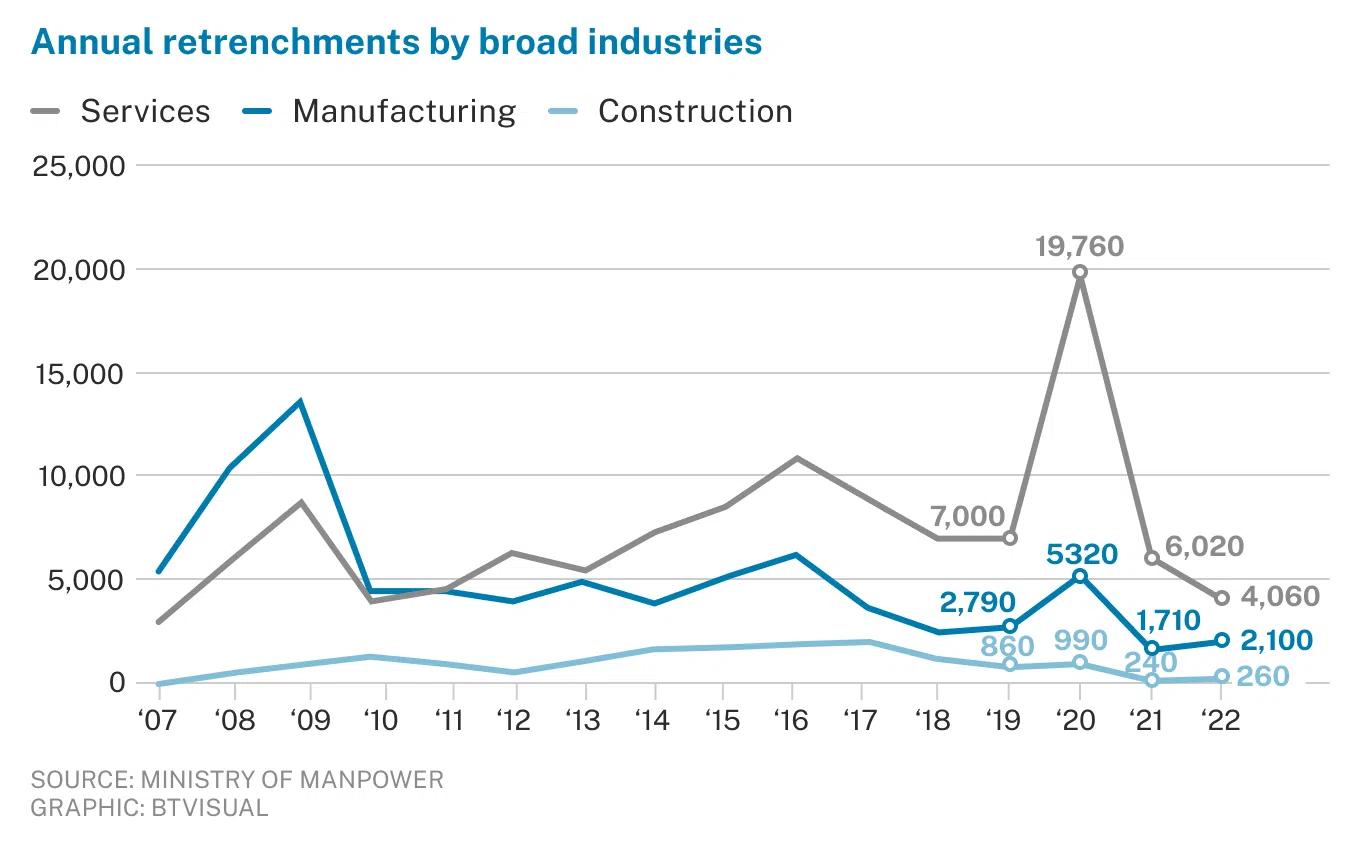Return of foreign workers sends Singapore’s total employment growth to record level in 2022

SINGAPORE’S total employment growth was at an all-time high in 2022, driven largely by the return of foreign workers following the relaxation of border controls in the first half of the year, the Labour Market Report indicated on Wednesday (Mar 15).
Total employment grew by an unprecedented 227,800 last year, reaching 2.9 per cent above its pre-pandemic level in 2019.
Non-resident employment constituted 88 per cent of the increase, amounting to 201,600. This was primarily due to the hiring of work-permit holders in sectors such as construction and manufacturing, said the Ministry of Manpower (MOM).
Even so, non-resident employment is still 0.8 per cent lower than 2019 levels.
Resident employment surpassed 2019 levels by 4.8 per cent last year, with an increase of 26,300. The increase was mostly in outward-oriented sectors such as financial services as well as information and communications, said MOM.
Annual average unemployment rates fell further in 2022, compared to the year before. Overall unemployment fell to 2.1 per cent, from 2.7 per cent; resident unemployment was down to 2.9 per cent, from 3.5 per cent; citizen unemployment was at 3 per cent, down from 3.7 per cent.
A NEWSLETTER FOR YOU

Asean Business
Business insights centering on South-east Asia's fast-growing economies.
Resident long-term unemployment also inched down to 0.6 per cent, from the pre-pandemic average of 0.7 per cent.
However, retrenchments in the fourth quarter more than doubled to 2,990, from 1,300 in the previous quarter, with business restructuring the top reason, said MOM. Electronics manufacturing accounted for the highest number of lay-offs, followed by wholesale trade and information and communication.
Still, total retrenchments in 2022, at 6,440, were lower than pre-pandemic levels.

Manpower Minister Tan See Leng said while the lay-offs in the electronics industry are partly cyclical in nature, geopolitical tensions have also resulted in the industry “being a bit more sort of protectionist”, which has had an impact on Singapore.
Still, the percentage of retrenched residents who found employment within six months increased to 73.1 per cent in Q4, the highest since Q2 2015. Most of them joined a different industry from the one they were laid off, MOM added.

The majority of tech sector lay-offs were for roles in general administration, marketing and business development; the incidence was lower among those with technical expertise, Dr Tan told reporters during a company visit.
“The good news is that, of the people who have been retrenched, a significant large majority of them have been able to find (jobs), or we’ve been able to place them in jobs within six months,” he said.
This, he said, is the result of “valuable lessons” learnt by the retrenchment taskforce over the last three years, particularly on job matching.
Still, the ministry is proceeding “very cautiously” and remains “guarded”, given the spate of tech lay-offs in recent months, as well as geopolitical tensions that show no sign of abating, said Dr Tan.
“The Ukraine-Russia crisis continues to drag and obviously, this has an impact in terms of global supply chains. On top of that, the recent collapse of a US bank has also sent shockwaves through much of the US, Europe and Asia,” he said.
MOM is expecting global economic headwinds and slower growth to weigh on labour demand, even if hiring sentiments in December 2022 remained positive.
Employment growth is likely to ease from last year’s increase and be uneven across sectors, MOM said.
Economists believe more retrenchments could occur in the first half of the year, given the gloomy manufacturing outlook and the restructuring in the tech sector.
UOB senior economist Alvin Liew said the weaker external demand and electronics down cycle are “typically a bad combination” for trade-reliant economies such as Singapore, South Korea and Taiwan.
“While retrenchments may pick up in tech and some segments of manufacturing, they may be more than offset by the increased hiring in in-person services industries amid the pick-up in tourism and business travel to Singapore and the region,” he said.
Maybank senior economist Chua Hak Bin is expecting employment growth to moderate to about 100,000 this year, driven by gains in the reopening sectors, including hospitality and aviation.
“Resident unemployment is already at pre-pandemic lows, and employment gains this year will have to be largely filled by non-residents,” he said. “China’s reopening will support job growth this year, and cushion the downsizing from tech and manufacturing firms.”
Amid the economic uncertainties, Dr Tan said it is essential for businesses to press on with transformation to digitalise, improve productivity and upskill their workforce.
“I don’t think we have that many options,” he said. “Transformation is really the key for our businesses and our workers to have that ability, to have that resilience to deal with all these headwinds that are coming our way, and to be responsive, nimble, and also have the agility to seize new opportunities.”
KEYWORDS IN THIS ARTICLE
BT is now on Telegram!
For daily updates on weekdays and specially selected content for the weekend. Subscribe to t.me/BizTimes
Singapore
Daily Debrief: What Happened Today (Apr 17)
An economy transformed: Lee Hsien Loong’s 20 years as Singapore’s Prime Minister
Singapore’s key exports on track for recovery despite March’s surprise 20.7% tumble: economists
Employers must process all flexi-work requests from Dec 1
New pathway sponsors faster professional qualifications for Singapore accounting undergrads
Daily Debrief: What Happened Today (Apr 16)
